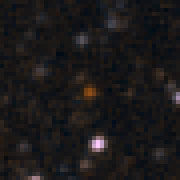WISE 0350−5658
Location of WISE 0350−5658 in the constellation Reticulum | |
| Observation data Epoch J2000 Equinox J2000 | |
|---|---|
| Constellation | Reticulum |
| Right ascension | 03h 50m 00.32s[1] |
| Declination | −56° 58′ 30.2″[1] |
| Characteristics | |
| Spectral type | Y1[1] |
| Apparent magnitude (J (MKO-NIR filter system)) | >22.8[1] |
| Apparent magnitude (H (MKO-NIR filter system)) | >21.5[1] |
| Astrometry | |
| Proper motion (μ) | RA: −208.7±1.0 mas/yr[2] Dec.: −575.4±1.1 mas/yr[2] |
| Parallax (π) | 176.4 ± 2.3 mas[2] |
| Distance | 18.5 ± 0.2 ly (5.67 ± 0.07 pc) |
| Details | |
| Temperature | 388±88[2] K |
| Other designations | |
| Database references | |
| SIMBAD | data |
WISE J035000.32−565830.2 (designation abbreviated to WISE 0350−5658) is a (sub-)brown dwarf of spectral class Y1,[1] located in constellation Reticulum, the nearest known star/brown dwarf in this constellation. Being approximately 18.5 light-years from Earth,[2] it is one of the Sun's nearest neighbors.
Discovery
[edit]
WISE 0350−5658 was discovered in 2012 by J. Davy Kirkpatrick and colleagues from data collected by the Wide-field Infrared Survey Explorer (WISE) in the infrared at a wavelength of 40 cm (16 in), whose mission lasted from December 2009 to February 2011. In 2012, Kirkpatrick et al. published a paper in The Astrophysical Journal, where they presented the discovery of seven new brown dwarfs of spectral type Y that had been found by WISE, among which was WISE 0350−5658.[1]
Distance
[edit]WISE 0350−5658 is one of the nearest known brown dwarfs: its trigonometric parallax is 0.184 ± 0.010 arcsecond, corresponding to a direct distance of 5.4 pc (17.7 ly).[3]
Physical properties
[edit]WISE 0350−5658 was observed together with WISEP J1738+2732 with the Gemini Observatory. The researchers found that non-equilibrium chemistry models reproduce the spectra of these two brown dwarfs better than equilibrium models. The researchers also found an effective temperature of 350±25 K and surface gravity of log g=4.0±0.25 for WISE 0350−5658. A mass of 7−9 MJ was estimated in this work.[4] Later work using the Spitzer Space Telescope and J-band photometry found that WISE 0350−5658 has a low tangential velocity, could be metal-rich and also found a similar mass of 3−8 MJ. These properties could be an indicator that it is a young Y-dwarf.[5] Another work using Hubble found a slightly higher mass of 7−13 MJ.[6]
See also
[edit]The other six discoveries of brown dwarfs, published in Kirkpatrick et al. (2012):[1]
- WISE 0146+4234 (Y0)
- WISE 0359−5401 (Y0)
- WISE 0535−7500 (≥Y1)
- WISE 0713−2917 (Y0)
- WISE 0734−7157 (Y0)
- WISE 2220−3628 (Y0)
References
[edit]- ^ a b c d e f g h i j Kirkpatrick, J. Davy; et al. (2012). "Further Defining Spectral Type "Y" and Exploring the Low-mass End of the Field Brown Dwarf Mass Function". The Astrophysical Journal. 753 (2). 156. arXiv:1205.2122. Bibcode:2012ApJ...753..156K. doi:10.1088/0004-637X/753/2/156. S2CID 119279752.
- ^ a b c d Kirkpatrick, J. Davy; Gelino, Christopher R.; Faherty, Jacqueline K.; Meisner, Aaron M.; Caselden, Dan; Schneider, Adam C.; Marocco, Federico; Cayago, Alfred J.; Smart, R. L.; Eisenhardt, Peter R.; Kuchner, Marc J. (2021). "The Field Substellar Mass Function Based on the Full-sky 20 pc Census of 525 L, T, and y Dwarfs". The Astrophysical Journal Supplement Series. 253 (1): 7. arXiv:2011.11616. Bibcode:2021ApJS..253....7K. doi:10.3847/1538-4365/abd107. S2CID 227126954.
- ^ Leggett, S. K.; et al. (2017). "The Y-type Brown Dwarfs: Estimates of Mass and Age from New Astrometry, Homogenized Photometry, and Near-infrared Spectroscopy". The Astrophysical Journal. 842 (2). 118. arXiv:1704.03573. Bibcode:2017ApJ...842..118L. doi:10.3847/1538-4357/aa6fb5. S2CID 119249195.
- ^ Leggett, S. K.; Tremblin, P.; Saumon, D.; Marley, M. S.; Morley, Caroline V.; Amundsen, D. S.; Baraffe, I.; Chabrier, G. (2016-06-01). "Near-infrared Spectroscopy of the Y0 WISEP J173835.52+273258.9 and the Y1 WISE J035000.32-565830.2: The Importance of Non-equilibrium Chemistry". The Astrophysical Journal. 824 (1): 2. arXiv:1603.09400. Bibcode:2016ApJ...824....2L. doi:10.3847/0004-637X/824/1/2. ISSN 0004-637X.
- ^ Leggett, S. K.; Tremblin, P.; Esplin, T. L.; Luhman, K. L.; Morley, Caroline V. (2017-06-01). "The Y-type Brown Dwarfs: Estimates of Mass and Age from New Astrometry, Homogenized Photometry, and Near-infrared Spectroscopy". The Astrophysical Journal. 842 (2): 118. arXiv:1704.03573. Bibcode:2017ApJ...842..118L. doi:10.3847/1538-4357/aa6fb5. ISSN 0004-637X.
- ^ Fontanive, Clémence; Bedin, Luigi R.; De Furio, Matthew; Biller, Beth; Anderson, Jay; Bonavita, Mariangela; Allers, Katelyn; Pantoja, Blake (2023-12-01). "An HST survey of 33 T8 to Y1 brown dwarfs: NIR photometry and multiplicity of the coldest isolated objects". Monthly Notices of the Royal Astronomical Society. 526 (2): 1783–1798. arXiv:2309.09923. Bibcode:2023MNRAS.526.1783F. doi:10.1093/mnras/stad2870. ISSN 0035-8711.


 French
French Deutsch
Deutsch